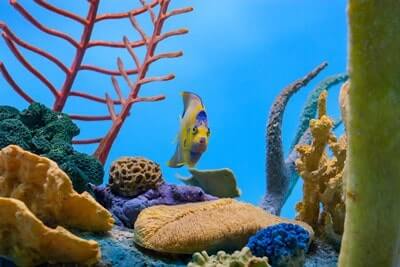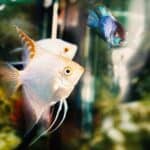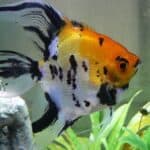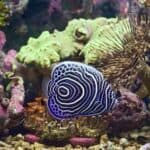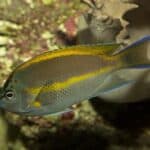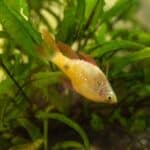Sometimes, angelfish lacks parenting skills. They might eat their eggs or abandon them entirely. If you’re breeding angelfish and want to avoid cannibalism, you can intervene.
Angelfish eggs can be raised without their parents. They can hatch into active fry if you help them survive those first 60 hours after fertilization.
When hatching angelfish eggs, remove them from the original tank or place them in a fry basket. You can dislodge the eggs from their nest with a razor blade.
Once in the new area, keep the temperatures between 75-82 degrees Fahrenheit and monitor the water’s chemical balance. Fungus will attempt to grow on the eggs, so treat the water with fungicide.
If any of the eggs die, remove them from the tank so they don’t contaminate the healthy eggs.
Angelfish eggs need steady oxygen, meaning the tank will need an airstone. They should be placed upside down on an object or plant within the tank. Never put them in direct sunlight.
Can Angelfish Eggs Survive Without The Parents?
Angelfish eggs can survive without the parents if you look after them properly. This will require you to:
- Use a fungicide to avoid fungal attacks on the eggs.
- Keep the water temperatures consistent, especially if you’ve moved the eggs from one tank to another.
- Use an air stone, which can boost the water’s oxygen levels.
- Keep the water at the right pH level so the eggs aren’t jarred or shocked.
When in egg form, fish are more delicate than ever. Angelfish are known as hardy fish that can tolerate a few changes outside of their ideal parameters. However, this is only true once they reach adulthood.
If the embryos are kept in water with a slightly elevated pH level, their survival rate decreases to 2%. However, few eggs will die if embryos are kept in the right water conditions.
According to Zygote, this is also true for temperature. The waters must remain slightly balmy at 75-82 degrees Fahrenheit to ensure the eggs hatch promptly.
Of course, the health of the parents also factors in. According to Aquaculture Research, if the angelfish parents have a rich diet, their eggs are more likely to survive and produce healthy fry.
Both formulated and raw diets are options, but the best results come from feeding angelfish squid, shrimp, fish eggs, and algae.
If the parent angelfish were healthy and well-fed, their eggs would be easier to raise artificially. If they’re sick or malnourished, the eggs are more delicate and may die, even in optimal tank conditions.
How Do You Take Care Of Angelfish Eggs?
You can let the angelfish parents handle this job in ideal conditions. However, there are cases where you absolutely must intervene to raise angelfish eggs artificially. For example:
- If the parents are young and inexperienced, they may eat the eggs.
- The parents may be overly territorial and cause fights with other fish.
- The parents may have died, leaving the eggs on their own.
- The parents may have abandoned their eggs.
- You may want the parents to reproduce again, which they’ll do if the eggs are gone.
No matter the case, you can take care of the angelfish eggs by yourself. Just follow these steps:
Locate The Eggs
If you decide to raise the eggs, you probably know where they are in the tank. However, angelfish may spawn in a secluded part of the tank, out of view, so the eggs’ location is better protected. Likewise, the parents may have cleaned out a nest for the eggs on some glass or mirror. This will make them hard to detect. To find the eggs:
- Look for a clean, smooth area. This is where angelfish like to spawn.
- Check on the side of the decorations. Your angelfish may have laid the eggs against a surface or stuck them on the side of a plant. Be sure to look at all angles.
- Pay attention to where the parents guard. Assuming both parents are alive, they will be hovering near the eggs.
It may be worth investing in spawning plates if you regularly breed angelfish. These create ideal spots to lay eggs and are easy to remove. You can locate and transfer the new offspring with less hassle.
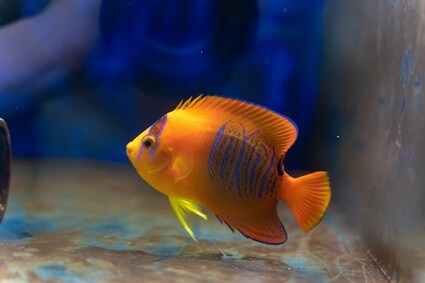
Make Sure The Eggs Are Fertilized
Female angelfish can lay eggs on their own without the intervention of a male. If the male does not come around to fertilize them, the eggs will remain sterile and lifeless.
You might waste your time if you can’t tell the difference between that or eggs on their way to hatching. Here are signs to look for:
- Fertilized eggs: These are brownish with translucent, amber tones. They will likely hatch in the next couple of days.
- Unfertilized eggs: These are white. Within a day or two, they’ll rot and get covered in fungi.
If the eggs are sterile, then be sure to clear them out immediately. The resulting fungus can unbalance your tank’s pH and sicken your fish. If the eggs are brown, then get ready for fishy adoption.
Decide Where To Move The Eggs
The new eggs should not be kept in the same tank as the rest of your fish. If the parents are not there to protect the offspring, they will quickly become a meal. The parents themselves may even eat the gooey eggs. To move the eggs, you have 2 options:
- A new tank: This is a long-term solution where you can let the fry grow to a safe size before getting reintroduced to the original tank.
- A fry basket: This is the least jarring option since you don’t have to get a second tank, cycle the new water, or invest in a new filter.
A fry basket works as a mesh netting or small container placed in your original tank. The eggs are set inside and kept away from the other tank inhabitants.
They’ll use the same water, which eliminates some of your guesswork. However, fry baskets can’t hold them forever and can overcrowd the original tank.
A new tank gives you space, security, and quarantine the fry. They will be vulnerable in these early hours, so a minor illness spreading in your original tank will be deadly.
You’ll need to get new water, cycle the tank, check the parameters, and buy a new aquarium.
Use The Same Water
Your eggs will be the safest and healthiest when kept in water from the original tank.
If you opt for a fry basket, that’s no issue. Keep the chemical balance properly leveled out and avoid sudden changes until the eggs hatch.
If you house the eggs in a new aquarium, use water from the original tank to fill it. Since fry doesn’t require a large tank, siphoning off a little from the parents’ aquarium won’t harm them.
Choosing Different Water
Of course, you can’t use the same water in some situations. For example, perhaps your original tank has an infection of some kind, or something damaged the tank, making the water null and void.
No matter the case, using new water to raise angelfish eggs is risky. If you have to, you can:
- Ask for water from a pet store. They already have cycled and well-maintained aquariums. It’s an unusual request, but most will oblige.
- Condition your water. If you need to use tap water, be sure to use a water conditioner to neutralize chlorine. The eggs’ chances of survival aren’t ideal in this case, but it’s doable.
- Treat the water. If a fungus has made your other tank unsafe for the eggs, the spores might follow your eggs to their new tank. Use methylene blue to treat the new water for fungus on the eggs.
Use A Heater
No matter your choice of water or enclosure, you’ll need a heater.
Angelfish eggs are vulnerable to changes in temperature. An adult won’t mind the water growing warmer or colder by a few degrees. An egg might do the following:
- Fail to hatch.
- Hatch far later than usual.
- Produce an unhealthy fry when it hatches.
That means you should keep your tank between 74 and 82 degrees. A heater will ensure you maintain this consistently.
Placing The Eggs
The eggs can’t be placed willy-nilly inside of the tank. In the wild (and even in your old tank), angelfish parents choose a nesting spot that will be:
- Flat.
- Secluded.
- Out of direct light.
- Away from fast-flowing water.
You should do the same. Likewise, the eggs must stick to whatever material they’re placed on. If they can’t do this, currents may drag them away.
Eggs will hatch best if they’re kept upside down. This improves how much oxygen passes over them and keeps them safe. You may have to try gently nudging them against an object a few times until they stay put.
Use An Airstone
Just like with adult angelfish, eggs need oxygen. You shouldn’t place the eggs in a fishbowl where the water remains stagnant. If you choose a new tank, include an airstone to keep the water adequately aerated. You should place it farther away from the eggs so they don’t get jostled.
If you’re keeping the eggs in the original tank, then whatever equipment you have to keep oxygen levels high is good enough.
Monitor The Light
Angelfish eggs will suffer under harsh or bright lighting. That’s especially true for direct sunlight, as UV radiation is dangerous for their developing cells. The sunlight will also encourage algae to grow. You should keep the tank in a secluded area away from windows.
Some breeders keep their egg tanks covered with a blanket to create darkness. Others use standard lighting. Neither method will directly harm the fish.
Watch For Filters
When raising the eggs artificially, use a low-powered filter or place it far away from the eggs. The strong water currents or suction may dislodge the eggs from their nest.
Once hatched, the fry may get sucked into the machine if the intake valves are not adequately covered.
Control Fungus
According to the International Journal of Veterinary Science and Medicine, angelfish eggs are susceptible to water mold. When the parents raise their eggs, most of their job involves cleaning away fungus and debris. If you adopt the eggs, this is now your job.
The best way to keep fungus away from eggs is to stop it from taking root. You can accomplish that by treating your tank with methylene blue.
You can mix formalin and hydrogen peroxide if you need stronger results or have just moved the eggs from an infected tank. These are the ingredients used by fish hatcheries in the U.S.
How to Remove Angelfish Eggs From The Tank
Removing angelfish eggs from their original tank is a delicate process. These gooey balls of life can be easily damaged. You won’t realize they’ve died until they fail to hatch and begin to rot.
Of course, if your angelfish have laid eggs on a movable object, like a spawning plate or plant leaf, that makes things easy. You can pick up this object and move it to the new area. You have to be careful if they are attached to a fixed surface, like the inside of the glass. To begin, you will need:
- A single-edged razor blade that has been sterilized with hydrogen peroxide.
- A specimen cup (paper or plastic).
- Water from the original tank is kept in the specimen cup.
Prepare the Area
Since you’ll be brandishing a razor and handling delicate eggs, be sure the area is ready for your operation.
- Turn off the filter or any air stones. You don’t want the current sweeping or sucking up the eggs once they’re loose.
- Consider removing the parents from the tank. Otherwise, they might race around the aquarium, disturb the eggs, or even try to attack your hands.
- With your hands, put the cup and razor into the tank. Hold the position for a few seconds. The other fish will go crazy for a few seconds but then calm down. You want this to happen while holding still, not while removing eggs.
Once the tank has settled down, you can proceed to the hard part.
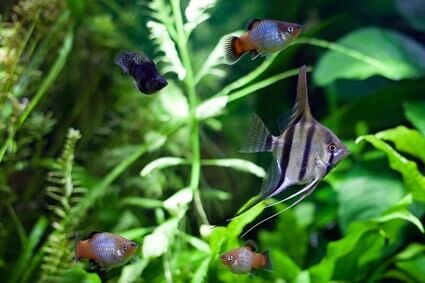
Remove The Eggs From Their Surface
Angelfish eggs are sticky and will adhere to whatever surface their parents laid them on. Before placing them in the cup, you need to dislodge them.
- Take the razor and position it next to the eggs
- Hold the razor parallel at about a 15-degree angle
- Press it down tightly to the object the eggs are on; you want this to be a smooth cut
- Slide it underneath the angelfish eggs until you have gently severed the bond between the surface and the eggs.
If you do this carefully, the eggs won’t break. Instead, they will accumulate upon the blade.
Place The Eggs In The Cup
The cup should already be in your hand, and the water. With the eggs on the razor, you can gently move them into the cup and press them lightly to the inside.
They may also drift off the razor and float to the bottom of the cup as you move it. As long as panicked fish don’t stir the water, you don’t have to worry about them drifting out.
Now, you can deposit them into the fry basket or new tank.
Raising angelfish eggs without the parents isn’t easy, but it won’t be time-consuming.
If the eggs are correctly cared for, they will begin to hatch within 60 hours. They’ll turn into wigglers in 2-3 days and swim freely around the tank.

